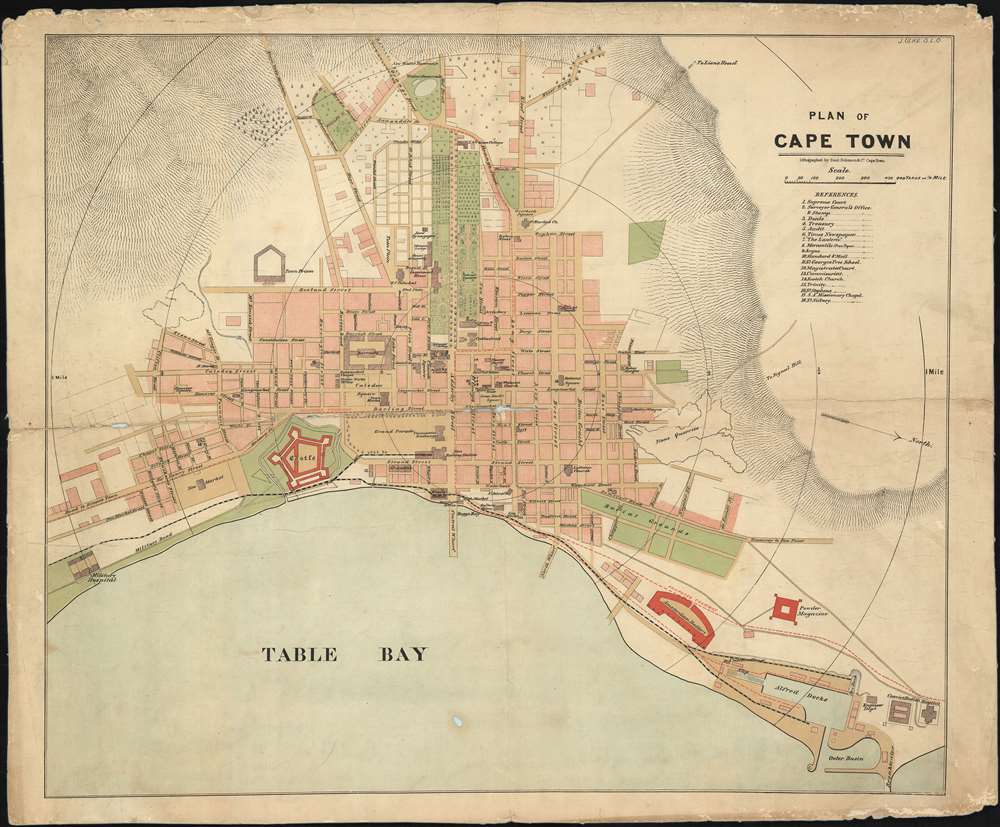This item has been sold, but you can get on the Waitlist to be notified if another example becomes available, or purchase a digital scan.
1882 Saul Solomon and J. Ulke Map of Cape Town
CapeTown-solomon-1882
Title
1882 (undated) 18 x 22 in (45.72 x 55.88 cm) 1 : 5750
Description
What's one the Map
The map presents a bustling racially, socially, and ethnically diverse city. Notable structures labelled directly include the ‘Jews Synagogue’ (founded on that site in 1863); 2 ‘Malay Mosques’ (an Indonesian and Malay community existed in the city since the 18th Century); churches of various denominations; markets; the great citadel of the Cape Castle; the army 'Barracks'; 'Government House'; the Masonic Lodge; and the Library and Museum.Additional structures are defined via a numerical key:
- Supreme Court
- Surveyor General’s Office
- Deeds (Land Office)
- Treasury
- Audit Office
- Times Newspaper
- The Lantern
- Mercantile (Free Paper)
- Argus
- Standard and Mail
- St. Georges Free School
- Magistrates Court
- Commissariat
- Scotch Church
- Trinity Church
- St. Stephen’s Church
- South Africa Missionary Chapel
- St. Sidney's Church
Publication History and Census
This map is undated, but the name of the cartographer, American Julius Ulke, appearing in the upper right, firmly dates this to Ulke's visit in 1882 to observe the transit of Venus with Simon Newcomb. The map was published in South Africa by the prominent publisher, Saul Solomon. There is only one edition and a single known surviving example - presently offered.CartographerS
Saul Solomon (May 25, 1817 - October 16, 1892) was a Jewish South African politician and publisher based in Cape Town. Solomon was born on St. Helena, where which his father, also Saul Solomon, arrived as a stowaway. Soloman Sr. developed a ship provisioning business on the island, becoming extremely wealthy. Soloman Sr. must have been quite stingy as, despite his wealth, he sent his son low-cost Jewish children's boarding house in London. There, young Saul Solomon suffered from malnutrition, leading to rickets, stunted legs, and other health issues that would plague him for the remainder of his life. As a young man, he moved to Cape Town to apprentice as a printer. He must have exhibited exceptional business acumen, a trait he doubtless inherited from his father, and bought his mentor's business. The Solomon printing concern steadily rose in size and respect, acquiring lucrative private and government contracts. By the second half of the 19th century, when this map was made, Saul Solomon controlled the largest printing concern in South Africa. In addition, he owned the Cape Argus newspaper, a liberal daily still in publication. He also founded Old Mutual, today one of South Africa's largest insurance firms. Beyond his business and publishing interests, Solomon was champion of liberal social and political values. He advocated for human equality and opposed all legislation that introduced distinctions based upon class, race, or creed. Alas, despite his influence, South Africa took another path. In any case, he continued to be active in both business and government, championing the Responsible Government Movement (1854 - 1872) and the Eastern Cape Separatist League (1854 - 1874). He was strongly against Lord Carnarvon's push to confederate the different states of Southern Africa. He retired from public life in 1883 due to poor health and moved to Kilcreggan, Scotland, in 1888, where in 1892 he died of Chronic tubular nephritis. His wife and children went on to prominent political, business, and artistic careers in South Africa. Despite his large publishing empire, Solomon is known to have issued only one map - a plan of Cape Town c. 1877. More by this mapmaker...
Julius Ulke (May 1833 - July 31, 1910) was an American cartographer, draughtsman, scientist, photographer, musician, and surveyor active with the General Land Office (G.L.O.) in the second part of the 20th century. Ulke was born in Brankenstein, Prussia (Germany) and emigrated to the United States in with his brothers, Lee Ulke and portrait artist Henry Ulke (1821 - 1910), later known as 'Painter of Presidents.' The brothers were involved with the German Revolutions of 1848–49 and were compelled to flee Germany on threat of retribution. Upon arriving in America, Ulke settled in Philadelphia, where he apprenticed as a photographer, eventually establishing his own business. Around 1858 or 1859, he moved to Washington D.C. where he established a photography gallery and studio - possibly in partnership with Henry. From about 1870, J. Ulke took a position as a clerk with the General Land Office. In the capacity of Principle Photographer, he accompanied Simon Newcomb's 1882 Africa expedition to observe the transit of Venus. There, on his own reconnaissance, he completed a map of Cape Town, South Africa, at a critical juncture in its development. Ulke lived most of his life in Washington D.C. where at some point he appears to have ran a gallery of photography on 1111 Pennsylvania Avenue, N.W. In fact, when Abraham Lincoln was shot at Ford Theater, he was taken across the street to the Peterson Boarding House (452 10th Street), the occupied by both Ulke brothers. Both Henry and Julius Ulke were among the 28 individuals present at Lincoln's death. It was Julius Ulke who took the several historic photographs, later immortalized as a painting by Alexander H. Ritchie, of Lincoln's Cabinet around his deathbed. He also photographed the bed after Lincoln was taken out. Ulke himself died at his home on 1427 U. Street NW, Washington D.C., and is interred at Rock Creek Cemetery. Learn More...

